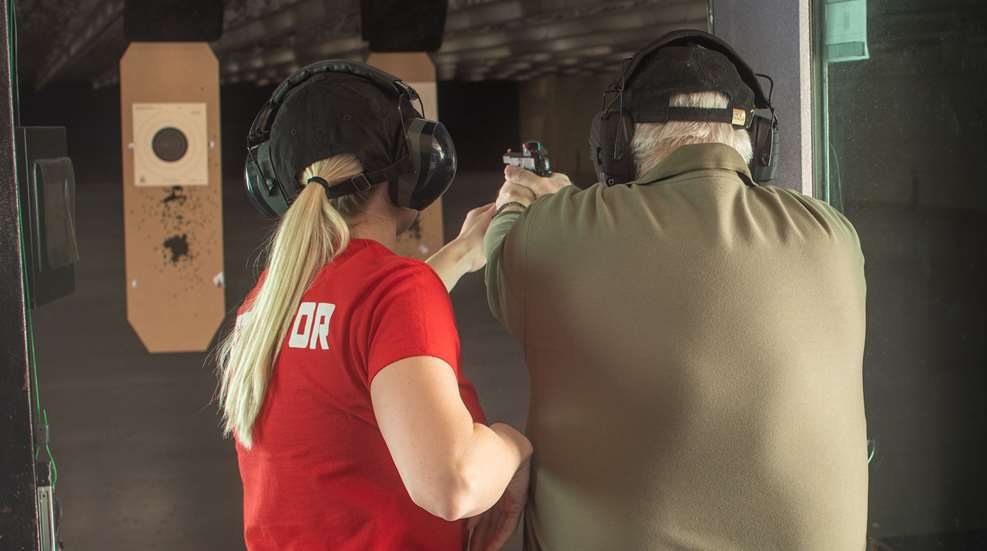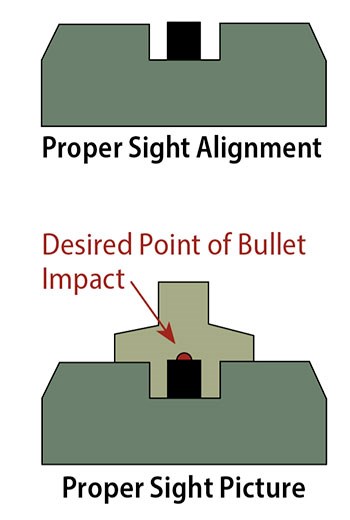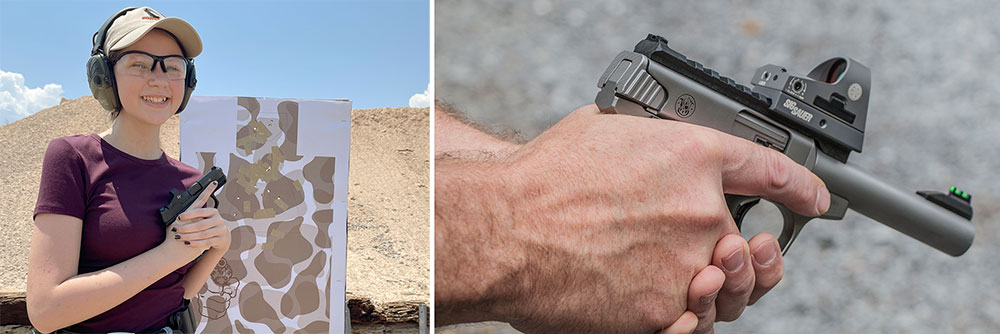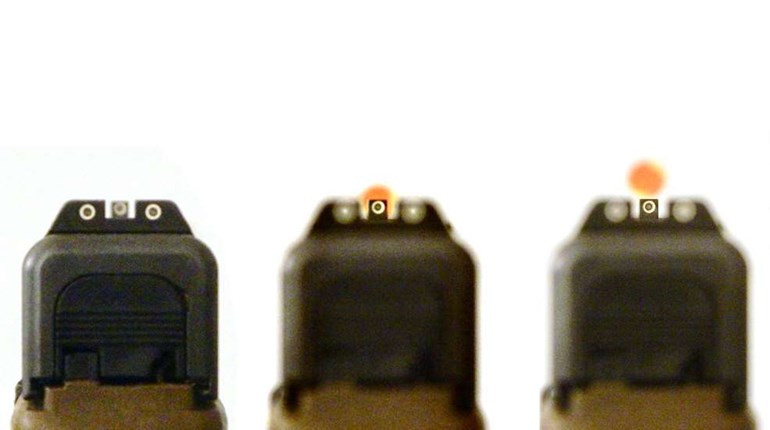
All good firearm instructors know the secret to shooting a handgun and hitting what you shoot at is the mastery of sight alignment, sight picture and trigger control (whether that’s achieved via learning to master the trigger pull or your grip). In my book, “Handgun Training for Personal Protection,” I offered that secret in the first paragraph of the first chapter. It’s too bad it’s not as simple as it sounds, but few things ever are. The problem with mastering the secret to shooting is attempting to learn to maintain the proper sight alignment and sight picture, while also trying to learn how to press the trigger properly.
I’ve been shooting handguns for a half-century, and I’ve been carrying a handgun most every day for about half that long. I’ve also attended a bunch of shooting schools and I’ve taught a lot of others how to shoot a handgun. I’ve even won my share of shooting competitions. However, I didn’t learn the secret to the secret to shooting until I began teaching my kids to shoot.
Sight Alignment
Half of the good-shooting equation is the proper alignment of your sights and their relationship to the target. If both are not correct, nothing you can do other than experience some luck will allow you to get a good hit. But, here’s the thing: Establishing the correct sight alignment and sight picture are the easiest parts of shooting. I can describe and demonstrate proper sight alignment and sight picture to you one time, and you will remember it forever.
 For proper sight alignment, you position the front sight in the middle of the notch in the rear sight, so the top of the front sight is level with the top of the rear sight. For the proper sight picture, you place the properly aligned sights on the target, so the top-center of the front sight is pointing at the spot on the target you want to hit. It’s that simple. Now you know it, and you’ll never have to see it demonstrated or learn it again.
For proper sight alignment, you position the front sight in the middle of the notch in the rear sight, so the top of the front sight is level with the top of the rear sight. For the proper sight picture, you place the properly aligned sights on the target, so the top-center of the front sight is pointing at the spot on the target you want to hit. It’s that simple. Now you know it, and you’ll never have to see it demonstrated or learn it again.
OK, I know, there are some sight systems that require slightly different alignment. With XS Sights’ Big Dot sights, you put the big-dot front sight in the center of the “V” of the rear sight, and then you place the dot over the spot you want to hit. Still, the concept is similar, and it does not change unless you’re trying to shoot at extreme distance.
So, why is it so hard to get hits with a handgun, especially when you’re just learning to shoot? It’s difficult because, while you’re trying to establish proper sight alignment and sight picture, you’re also trying to learn to press the trigger without altering either. It’s just like the old parlor trick of trying to pat your head with one hand while rubbing your tummy with the other. Learning/doing multiple things at the same time is never easy.
Pressing the Trigger
The first thing you must learn is the hardest, and that’s how to press the trigger properly. Unlike with sight alignment—which you only have to be taught one time—for the rest of your life you’ll be learning to press a trigger correctly. No matter how good you get at it, there will be times when you do it incorrectly. This is why masters like Jerry Miculek sometimes miss. It’s a fact of life; accept it. Your goal is to minimize the percentage of bad trigger presses.
You can get better at pressing a trigger, but you have to practice pressing the trigger to do so. The good news is that you don’t have to shoot for this learning to take place. The easiest way to improve your trigger pressing skill is by conducting dry practice. But, this dry practice is likely a bit different from what you have done before.

Some folks call the process of learning to press a trigger “establishing muscle memory.” Muscles, of course, do not have a memory, but your brain—the thing that controls your muscles—does. When a specific movement is repeated over time, the brain creates a memory of that movement, eventually allowing it to be performed with minimal conscious thought. Until that happens with your trigger press, you’re not going to consistently hit anything with a handgun. This is especially true if you’re trying to develop that memory while also attempting to align the sights correctly and achieve a proper sight picture.
I know what you’re thinking: If you cannot learn to use the sights and press the trigger at the same time, how are you supposed to learn to shoot? That’s a good question.
The Secret to the Secret
The first thing a new shooter wants to do when they get a new handgun is shoot it. That’s fine. Do it and get it out of your system. You’ll see if it works, and you’ll discover what the recoil feels like. Once that’s over, take your handgun home, give it a good cleaning and then begin a dry-practice routine where you press the trigger over and over and over, until you can do it—almost subconsciously—without the gun moving.
For sure, follow all the safety rules just like any other time you’re conducting dry practice, but there’s no use trying to aim—that only complicates the learning process. Remember, you can only effectively learn one thing at a time. You see, if you’re pulling the trigger while aiming, you must divide your focus between the sights and the trigger. The more you focus on attempting a good trigger press, the less you can focus on the sights, and vice versa. Trying to do both induces trigger panic and trigger jerking, and now your brain must work to overcome those errors.
Sometimes you’ll see instructors put their finger over the shooter’s finger while the shooter aims at the target. Then, the instructor will press the shooter’s finger and the trigger. The idea is that the shooter will then experience what a proper trigger press feels like. This works to some extent, but while this is happening the shooter is still concentrating on the sights. Dry practicing the trigger press without moving the handgun—and without any attention being paid to the sights—is a better approach.
Unlike with sight alignment—which you only have to be taught one time—for the rest of your life you’ll be learning to press a trigger correctly.
Enter the Red Dot
One you can consistently press the trigger without the handgun moving, the next step is to bypass the sights. I’ve been working with miniature red-dot sights on defensive handguns a lot lately. And while I think they’re fabulous at enhancing accuracy, I’m still not convinced they’re ideal for personal protection. This is partly because they sometimes fail, and partly because sometimes the sun or artificial light can make them unusable. However, if precision is your goal, they’re much better at helping you achieve it than traditional open sights.
This is mostly because they allow you to divert a portion of your concentration to the trigger as opposed to sight alignment. You still have to manage sight picture, but no longer do you need to focus on the target, the front sight and the rear sight. You just put the dot on the target. Before I took my daughters to Gunsite, I taught them how to press a trigger. At Gunsite they used a 9 mm pistol with a miniature red-dot sight and almost immediately were getting good hits. This was partly because aiming with a red dot was easier, but mostly because they already knew how to press a trigger.
Finishing the Process
Once you can shoot your handgun accurately with the red-dot sight, you can either leave it on the handgun or revert to open sights. You’re not going to be as accurate with the open sights, and you’re not going to be as fast. Initially, you’re also going to struggle a bit with maintaining sight alignment and sight picture through the shot process. But this will quickly pass, because since you already know how to pull a trigger, you can apply more concentration to the sights.

When I started seriously teaching my son how to shoot a pistol, he was struggling. I just happened to have a SIRT laser-training pistol, which has a laser that is constantly on. I told him to just play with the training pistol by trying to press the trigger without allowing the laser to move. He was playing, but he was also learning, and it wasn’t long until he was dead steady. We transitioned to a pistol with a red-dot sight, and he was immediately getting hits.
He soon started working with an open-sight centerfire pistol and when he was 16 years old, he took the adult version of the 250 Pistol Course at Gunsite Academy. Even though the class was full of adults, he won the man-on-man shoot-off, despite being just a young teenager. This was all possible because he first learned the secret to the secret—he learned to pull a trigger properly. After that, everything else in-volved in shooting well came easy.
Like I said, learning proper sight alignment and sight picture is easy part. Learning to press a trigger correctly—without inducing movement to the gun—is the hard part. Learn the hard part (managing the trigger) first, then put the two together. Trying to learn both simultaneously can be extremely frustrating and can also lead to the wasteful expenditure of a lot of ammunition. The good news is that once you learn trigger control, the skill will translate to other firearms as well.






































